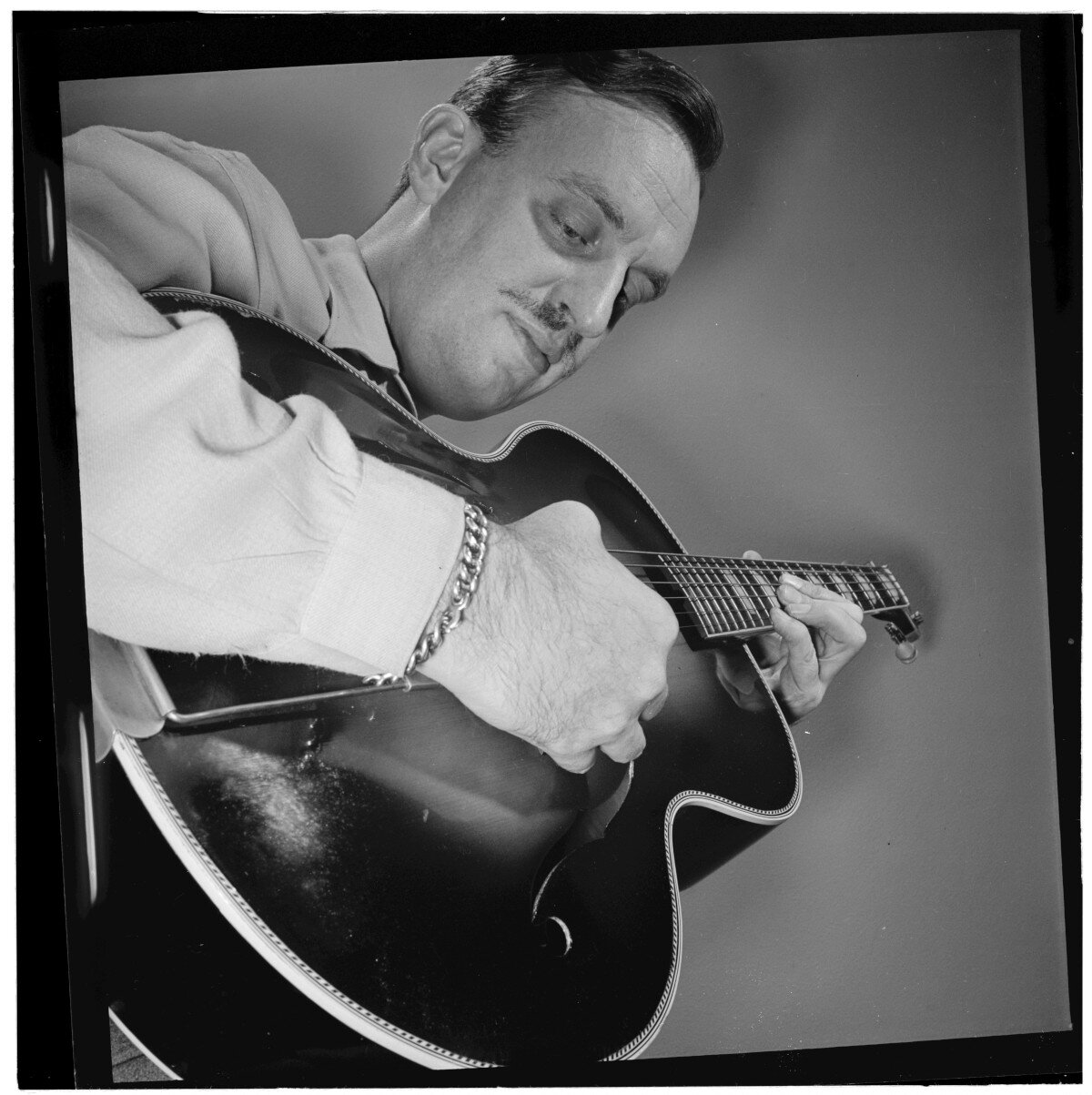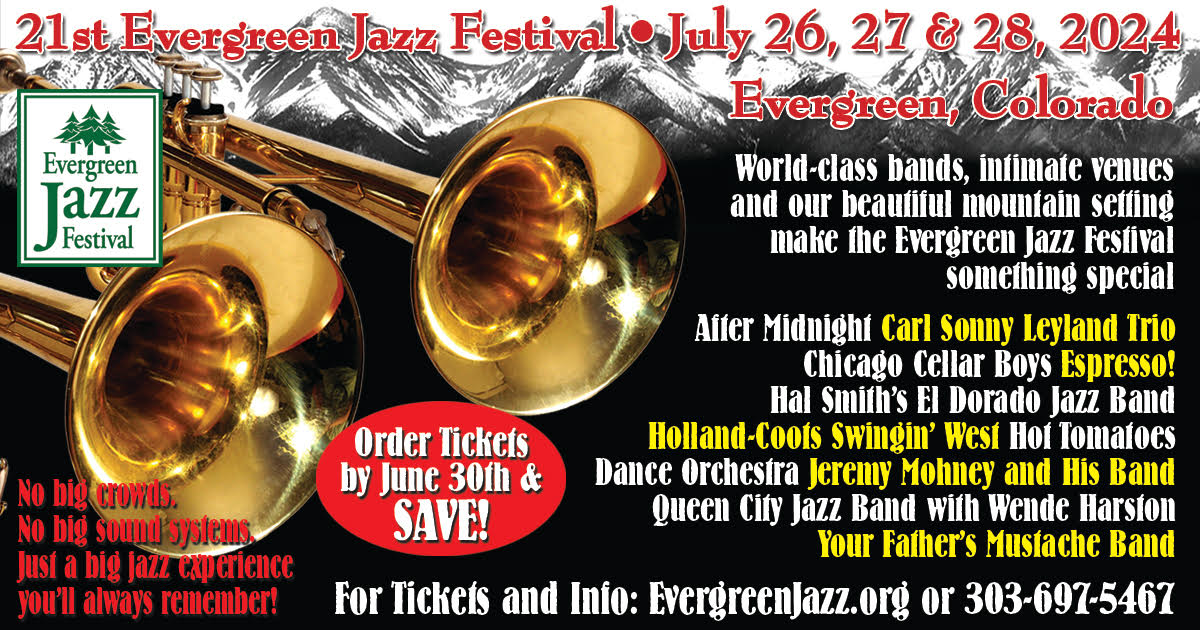My wife Laura I lived in New York City for nearly fourteen exciting years, from early 1983 until the summer of 1996. It seemed that a whole musical world opened up to me. I got to meet, hear, and even play with many of my musical heroes; men and women who were just names (albeit important names) on the backs of LP albums I’d listened to while growing up in southern California.
Our son Andrew was born at New York Hospital in Manhattan, I’ve told him to be proud he’s a native New Yorker. Some of the finest people I’ve ever known (several who have become lifelong friends) are—or were—New Yorkers. The Big Apple is a special place, filled with special people, and many of the finest musicians in the world.
I moved to New York City at the behest of my longtime friend, Howard Alden. For those of you who don’t yet know about Howard, he is inarguably one of the finest jazz guitarists to ever pluck a string. In a world of remarkable musicians, Howard is one of the more remarkable. Howard is the one who took me to Eddie Condon’s Jazz Club in mid-town Manhattan during the first week after I’d arrived into town. Cornetist Ed Polcer—still sounding great–shared ownership of the club, along with his business partner, the late Red Balaban. Howard had insisted I bring my trombone with me to Condon’s and sure enough, Ed invited me to play the last set. I found out that this too was Howard’s doing, and that Howard had briefed Ed about me before we came in.
Condon’s soon became my “home away from home.”
I played there many times. Even if I wasn’t working on a given night, I would usually be at the bar, listening to whomever might be playing on that particular evening. It was there I got to hear and meet the great Vic Dickenson, one of the most unique voices to ever play the slide trombone.
Just stop and consider that name: Vic Dickenson. There’s something musical about it; the way the first syllable of the last name rhymes with the first name. I suppose it happens simultaneously: when a young person discovers jazz, he or she discovers the many unusual names of its many practitioners. I was in eighth grade when I discovered jazz. My father had perhaps a hundred or so 78 rpm discs he’d stashed in a hall closet. He didn’t listen to them much by then, but I guess he couldn’t bear to part with them. (I’m hip, Dad.)
I’d been playing trombone for about three years, and I knew some of those discs featured trombone players I’d read about, or ones my Dad had mentioned. I went through the rows of records, and was rewarded with three discs that made a huge impact on me. One was a reissue of a 1929 recording by Red Nichols and His Five Pennies. (“Red Nichols?” Now, there’s a quirky name! And his band, the Five Pennies. Hey, I get it!: Nichols and five pennies…hooo, boy.)
The two songs (one on either side of the thick brittle disc) were “(Back Home Again In) Indiana,” and “Dinah.” Both featured solos by a very young Benny Goodman, and a slightly older trombonist: Jack Teagarden. Now, what kind of a name was that? Teagarden? Unusual, and memorable; like his style of playing.
Another disc—on the RCA Victor label—held the beautiful version of “Star Dust“, recorded in 1940 by Artie Shaw and His Orchestra. The side opens with no preamble; just three wonderfully-played pick-up notes by trumpeter Billy Butterfield, who goes on to play one of the greatest solos of his long career. Hmmm…“Billy Butterfield”…another interesting jazz name, what with its nice alliteration…
After clarinetist Shaw plays a frighteningly good solo, his star trombonist comes in for a brief, eight-bar statement near the end of the record. The trombonist had an alliterative name like Butterfield’s: Jack Jenney. His lyrical eight bars are an absolutely beautiful, completely-formed musical statement, played with a control and beauty of tone that few other trombonists could have possibly rivaled at that time. After that record came out, Jenney’s solo had trombonists all over the USA scurrying off to their practice rooms!
The trombonist on the last of the three discs I discovered that day was another individualist with a unique, personal style. The disc was a twelve-inch 78 on the Black and White label. The label’s name referred to the black and white keys on a piano, of course, but it also was a subtle clue that the label often featured racially-integrated bands, still unorthodox in the 1940s.
The group on this disc happened to be all-Black, though, and was led by Lil Armstrong, Louis Armstrong’s ex-wife. (A sign of the times is that on the label, she and the group are billed as “Lil ‘Brown Gal’ Armstrong and Her All-Star Band.” (Years later, I found out that in the late 1930s, she had composed and recorded a poignant song called “Brown Gal.” It had become a small “hit” for her, and Lil was closely identified with that song throughout the late ’30s, into the ’40s; maybe the rest of her life).
The side opens with Lil’s piano striking a clear, open chord. A trumpet, ringing with authority, plays a two-bar introductory phrase, and then goes on to give us an especially warm and thoughtful version of the old favorite, “I’m Confessin’.” This was the great Jonah Jones (yet another alliterative jazz name), who had made a few swinging sides with Lil Armstrong in Chicago before joining Cab Calloway’s band in 1941. The record label informed me that the disc was recorded in “Chicago, 1945.” By then, Jones had made a trip to Chicago from New York, and enjoyed a reunion session with his old boss, Lil Armstrong.
A clarinetist named Al Gibson—whom I have been told was also a Calloway sideman—plays the bridge in a style reminiscent of the New Orleanian Barney Bigard. Then Jones returns to finish the chorus. There’s a sudden and unexpected “break,” and the two measures are filled with a shouting, earthy, chocolate-brown tone of the session’s trombonist. His name still strikes me as unique, but as an eighth-grader, it was humorous and delightful: J. C. Higginbotham! J. C. Higginbotham! I would say it over and over, just to hear it out loud.
And what a trombonist he was! The blues was in every note, and that dark, rich tone he had was addicting. I was overjoyed as I listened to the record. After the brief solos by Jonah Jones and clarinetist Gibson, it was all “Higgy’s” record. He plays a beautiful, singing cadenza at the end, and the only thing to do was play the record all over again.
So, we have: Vic Dickenson; Billy Butterfield; Jack Jenney; Jack Teagarden; Jonah Jones; J. C. Higginbotham…jazz history is peppered (Art Pepper?) with odd and affecting names like these, and many more: Bix; Tram; Bing; Floyd “Horsecollar” Draper (he played alto sax on the earliest recordings by Jelly Roll Morton). Hey! Jelly Roll Morton! Now, there’s a jazzy name!
Let’s see: Muggsy Spanier; Wild Bill Davison; Dave Tough; Pee Wee Russell; Frog Joseph; Big-Eye Louis Nelson; Trigger Alpert; Zoot Sims; Al Klink; Ruby Braff; Mary Lou Williams; Bessie Smith; Billie Holiday; Chauncey Morehouse; Happy Cauldwell; Howdy Quicksell…Bird, Pres, Hawk, Dizzy…Shorty Baker and Big Boy Goudie…Cat, Cozy, and Cootie. Condon, Kaminsky and Kress. Don’t forget Carney!
Then there are the English cats: Sir Humphrey Lyttelton; Digby Fairweather; Brian Lemon; Tommy McQuater; Terry Lightfoot; Mister Acker Bilk…and over in France, there was Django.

So many wonderful, colorful names. One of my all-time favorite names, however, was that of a brilliant, yet little-known guitarist and composer-arranger: Brick Fleagle.
New York is famous for its Broadway stage shows and musicals. Before computer programs for musical notation had been developed, composers and arrangers wrote music the “old-fashioned” way: with pen or pencil on score paper. Of course, the individual parts then had to be “extracted” (that is, copied) from the score by a copyist.
The shows on Broadway, big bands, small groups, and the countless recording sessions taking place around town provided work for many arrangers and copyists who worked in various “music houses” around town.
Associated Music was a popular store which sold a wide variety of score and manuscript paper. The store also offered a selection of professional copying pens, ink, straight-edge rulers, plastic triangles, and the other equipment used by composers, arrangers, and copyists in those days.
Whenever I would go there for music paper and supplies, I was impressed by the row of copyists—about seven or eight men and women—lined up against the two far walls of the store. It seems that they were always there, at any time of day or night. Each copyist had his/her own small desk. A desk lamp was clamped to the edge of the table, and had an extension so the light could be brought directly over the top of the table. Many of the copyists—including a few of the women—wore dark green visors, like old-fashioned bank tellers wear in old movies. It was all something to see, and very interesting to me.
While copying parts for my own arrangements at home, I learned through trial—and too many errors—that one simply can’t drink alcohol and try to copy accurately at the same time! The first glass of wine usually doesn’t pose any problems, but after the second or third glass, you will certainly start making mistakes. At least, I did! When you are hand-copying a part in India ink, as copyists did in those days, this can be serious!
I had occasion to visit trombonist/arranger Billy Byers, who was using pianist Joe Bushkin’s Manhattan residence as a workplace for a few weeks, while Joe was out of town.
Mr. Byers was copying in ink on vellum paper, which is also called “onion-skin.” Vellum is very thin, translucent paper which could be easily reproduced in those days, and was used for Broadway show scores. It is very fragile, delicate paper, and writing on it requires great care, skill, and accuracy. Mr. Byers was a master, of course. (I somehow recall the show he was working on: Private Lives.)
By now, I hope we’ve established that copyists work best when sober! This doesn’t change the fact that many of them enjoy a “taste” now and then, but that’s almost always after they finish their copying for the night.
So now, let’s return to Eddie Condon’s Jazz Club, circa 1984. I was sitting at the bar when a tall, slender, grey-haired man sat down on the stool next to mine. His hair was styled more or less like Albert Einstein’s, and he looked very tired. He was wearing blue jeans, and some kind of red plaid flannel shirt. He had a long, handsome face, a ruddy complexion, and a thick grey gunslinger’s mustache.
The bartender at Condon’s served very occasionally as the club’s “bouncer.” He was a friendly guy who we knew as “Big Jim.” He came toward us, and set a bar napkin down in front of the man who had just arrived. He looked at him and said, “Good evening, Brick! What would you like?”
“Hello, Jim. I guess I’ll have my usual…”
Jim nodded, and instantly returned with a vodka over ice. Brick took a couple of sizable gulps, and sighed. He raised his instantly empty glass, and Jim nodded.
While Jim was fixing Brick’s next drink, I turned to Brick and said, “Good evening, sir. I heard Big Jim call you ‘Brick.’ Would you by any chance be Brick Fleagle?”
The old man raised his eyebrows, and considered me for a moment. Jim quietly placed Brick’s new drink in front of him.
Brick picked it up. He held it up to the light and turned it one way, and then around. I actually think he was admiring it. He took a healthy swallow, and set the glass down. He looked at me again.
“Indeed I am, young man. Brick Fleagle, in the flesh! And with whom might I have the pleasure of exchanging these pleasantries?”
“My name is Dan Barrett, Mr. Fleagle. I’m a trombone player. I moved here last year from southern California.”
“Ah,” he said. He set the second empty glass down on the bar quietly, and a little too carefully. “Welcome to the Big Apple. And how is it, young Mister Barrett, that you would know anything at all about me?”
“Well, sir,” I said, “I’ve known your name for years, from the records you made on guitar with Duke Ellington’s band, and for HRS, with Rex Stewart and the Ellington guys…”
“Hmmm.” He grunted as he shook his head. “That frankly amazes me! Why, an unexpected, wonderful surprise like that calls for a drink!”
I laughed, and indicated to Big Jim that I’d get Mr. Fleagle his next round. I got another beer. I couldn’t let the old guy drink alone.
Over the next couple of drinks, Brick (he insisted I call him by his first name) told me about hanging out with Rex Stewart, who was an exceptionally close friend. He also spoke of Harry Carney, and another of my heroes, trombonist Lawrence Brown. He had nothing but praise and admiration for all of them.
I remember he told me of his excitement when the guys all agreed to meet him at a studio and record his compositions and arrangements. I also remember the awe he expressed when he told me that as good as he knew they would make his writing sound, he said, “When they began to play, it sounded so much better than anything I’d ever envisioned! I couldn’t believe I’d written that stuff! It was…like magic, how wonderfully they played it all!”
Brick had arranged and copied many charts for Ellington. Brick’s swinging charts could also be found in the books of bandleaders like: Jimmie Lunceford; Fletcher Henderson, and Chick Webb. We talked about arranging a little bit, and I told him how much I liked Fletcher Henderson’s writing, and the way he would use clarinet trios.
Brick took a sip of what must have been his fifth big vodka in a short amount of time. I’d love to say he didn’t show any signs of it, but to be honest, he was fairly hammered. He was still pleasant, however, and I was of course honored to spend time with him.
“Now, Daniel, those clar’nets. You know what all tha’ was about, don’t you?” (Man, his speech was really slurred by now.)
“Well,” I said, “I thought it was an exciting, uh, brilliant sound…er, no, I guess I don’t know. What was it ‘all about?’ ”
Brick said, “I knew “Smack”—that is, Fletcher–pret’ well. He was a very quiet, shy man. A real gentleman. His brother Horace was more…outgoing. But Fletcher, he was very religious. He was raised in a strict household, and went to church ev’ry Sunday.”
He took another sip of vodka.
“So, now do you know what all the clar’nets were about?” He tried to look at me, but his eyes weren’t quite tracking.
“I’m sorry, sir,” I said. “I really don’t understand where you’re going with this…”
Brick slammed his hand down onto the bar. A couple of customers looked over, and then went back to listening to cornetist Ed Polcer and the great house band he led at Condon’s. I figured Ed would forgive me for talking to Brick instead of listening just this once.
Brick composed himself, and went on.
“Look, man! Fletcher grew up in the Baptist church! He was a very religious man, and the music he heard at those services had a huge effect on him! Think about how he used those clarinets. Those clarinet trios…see, for him, they were the WOMEN in the church choir, wailing away! And the riffing brass, with the plungers going…well, they were the MEN in the church, answering the WOMEN. You see?”
I felt like someone had suddenly opened a door to a much deeper perception of what jazz was all about, or what it COULD be about, or maybe even what it SHOULD be about.
I nodded. After that, I didn’t move. I just sat still, and tried to take it all in. Brick looked at me for a moment, and then he smiled, satisfied that he’d finally gotten through to me. He dug some money out of a pocket, and placed it carefully on the bar. Brick slowly rose from his stool. He caught Big Jim’s eye, and indicated the money. Jim was counting change for another customer, but he nodded, and said good night to Brick.
I stood when I saw Brick getting up to leave, and helped him with his coat. I thanked him for his time, and we shook hands. He walked carefully out into the night. I watched him go. I knew there were taxi cabs right out in front, so I wasn’t too concerned about him. Besides, he’d made it this far in life!
It was an amazing story told by an amazing man with that one-of-a-kind name. Now, whenever I hear a Goodman or Henderson record with a clarinet trio, I think of Brick Fleagle and those special insights he shared with me that evening at Eddie Condon’s.



























